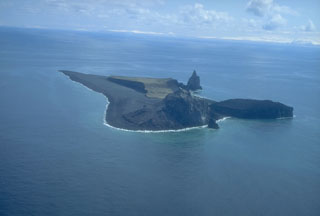Report on Bogoslof (United States) — 23 August-29 August 2017
Smithsonian Institution / US Geological Survey
Weekly Volcanic Activity Report, 23 August-29 August 2017
Managing Editor: Sally Sennert.
Please cite this report as:
Global Volcanism Program, 2017. Report on Bogoslof (United States) (Sennert, S, ed.). Weekly Volcanic Activity Report, 23 August-29 August 2017. Smithsonian Institution and US Geological Survey.
Bogoslof
United States
53.93°N, 168.03°W; summit elev. 150 m
All times are local (unless otherwise noted)
AVO reported that a satellite image of Bogoslof acquired at 0628 on 24 August showed elevated surface temperatures and a small plume that was most likely steam drifting 17 km S. During 24-25 August a robust steam plume drifting 70 km SE and elevated surface temperatures were identified in satellite data. A four-minute-long explosion that began at 1629 on 26 August generated an eruption cloud that rose 8.2 km (27,000 ft) a.s.l. and drifted SE. The event was also observed in seismic and infrasound data, and one lightning stroke was detected.
Three short-duration eruptive events occurred during 27-28 August. The first, a two-minute-long explosion at 1508 on 27 August, produced a volcanic cloud that rose 7.9 km (26,000 ft) a.s.l. and drifted SE. The second event started at 0323 on 28 August and lasted 25 minutes. The resulting small cloud drifted ESE and quickly dissipated. The third event was detected at 1117 on 28 August and generated a small volcanic cloud that rose 7.6-9.1 (25,000-30,000 ft) a.s.l. Slightly elevated surface temperatures were observed in a few satellite images during 28-29 August. The Aviation Color Code remained at Orange and the Volcano Alert Level remained at Watch.
Geological Summary. Bogoslof is the emergent summit of a submarine volcano that lies 40 km N of the main Aleutian arc. It rises 1,500 m above the Bering Sea floor. Repeated construction and destruction of lava domes at different locations during historical time has greatly modified the appearance of this "Jack-in-the-Box" volcano and has introduced a confusing nomenclature applied during frequent visits by exploring expeditions. The present triangular-shaped, 0.75 x 2 km island consists of remnants of lava domes emplaced from 1796 to 1992. Castle Rock (Old Bogoslof) is a steep-sided pinnacle that is a remnant of a spine from the 1796 eruption. The small Fire Island (New Bogoslof), about 600 m NW of Bogoslof Island, is a remnant of a lava dome formed in 1883.
Source: US Geological Survey Alaska Volcano Observatory (AVO)

